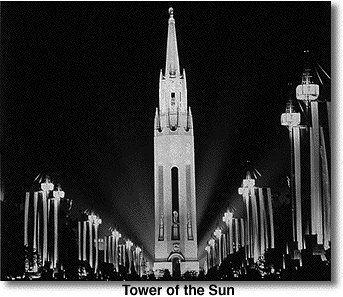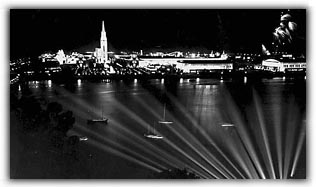|
Night Lighting ... How It’s Done
 When the forty weeks of San Francisco’s
World’s Fair are over, 40,000,000 kilowatt hours of electricity will have been consumed in
producing the night picture, painted in light, on Treasure Island. Three 9,000-foot
submarine cables, more than 35,000 miles of cables, provide the “juice” required for the
amazing color effects. A budget of $1,500,000 has been given to the illuminating
engineers, directed by A.F. Dickerson, expert of the General Electric Co., unparalleled
opportunity to carry out the most comprehensive and unified program of exterior lighting
ever attempted. When the forty weeks of San Francisco’s
World’s Fair are over, 40,000,000 kilowatt hours of electricity will have been consumed in
producing the night picture, painted in light, on Treasure Island. Three 9,000-foot
submarine cables, more than 35,000 miles of cables, provide the “juice” required for the
amazing color effects. A budget of $1,500,000 has been given to the illuminating
engineers, directed by A.F. Dickerson, expert of the General Electric Co., unparalleled
opportunity to carry out the most comprehensive and unified program of exterior lighting
ever attempted.
Except in the Gayway, where bright lights are the stimulant to fun and frolic, indirect
lighting prevails. Roadways and walks are lighted with gigantic lanterns. Varying in height
to as much as 86 feet, cylindrical lanterns, five feet in diameter, are made of heavy canvas
treated with glyptol, giving a parchment glow. These “shades” are hung over a framework
of stout steel shaft and steel hoops. One hundred 60-watt and 100 40-watt lamps are
screwed into the central shaft and when lighted consume 10 kilowatts of current. Each light
standard weighs approximately 2400 pounds and requires as much as 180 square yards of
fabric. Other lanterns, from 30 to 50 feet high, are patterned after Siamese ceremonial
umbrellas, lyres, and other designs.
 Great 70-foot-high walls of stucco, flecked with iridescent vermiculite (flakes of super-heated mica), have large circles of colored light to form contrasts against the ivory
background, and floodlighted trees cast spidery silhouettes. Hidden in troughs, tucked in
branches, clustered in tree baskets, almost buried under shrubs, are 10,000 colored
floodlights, including 2400 pink, blue, gold, and green gas-filled fluorescent tubes, 130
searchlights and 300 ultra-violet mercury or “black light” lamps to produce the startling
effect of color masses and patterns. Light is graded in intensity from the base of buildings
to the top to maintain the depths of arcades and accentuate architectural set-backs.
Great 70-foot-high walls of stucco, flecked with iridescent vermiculite (flakes of super-heated mica), have large circles of colored light to form contrasts against the ivory
background, and floodlighted trees cast spidery silhouettes. Hidden in troughs, tucked in
branches, clustered in tree baskets, almost buried under shrubs, are 10,000 colored
floodlights, including 2400 pink, blue, gold, and green gas-filled fluorescent tubes, 130
searchlights and 300 ultra-violet mercury or “black light” lamps to produce the startling
effect of color masses and patterns. Light is graded in intensity from the base of buildings
to the top to maintain the depths of arcades and accentuate architectural set-backs.
“Black light” projected on invisible weather-resistant luminescent paints in niches, on
murals, and sculptures, produces the startling “colored pictures” that stand out in an almost
phosphorescent glow against adjacent colored walls. Primary colors are mixed together to
obtain new colors. Pink fluorescent tubes crossed by blue floodlights produce mauve,
Trees lighted green stand out against the background of pale tinted walls. Fountains are
lighted with their own colors. In the Court of Pacifica, a thyratrone behind the scintillating
Persian Prayer Curtain produces a rotation of colors varying from dark blue to pale apricot.
Switches and buttons on an electrical control board in each building are set permanently
wherever the color scheme is static. Fountain lights are controlled from the bases of nearby
statues. Controlling all these is a set of four switches on a master switchboard which can be
turned on at any given hour.
Overhead is a scintillator of light covering Treasure Island just a few feet above the 400-foot Tower of the Sun. Twenty-four gigantic searchlights, 36 inches wide, in eight
different colors, are mounted on the north side of Yerba Buena Island. These army-sized
lights, when turned on for special occasions, are manned by a crew of 24 and generate
1,440,000,000 candlepower of light visible for 100 miles.
In: Official Guide Book
Golden Gate International Exposition
Return to
top of page
|